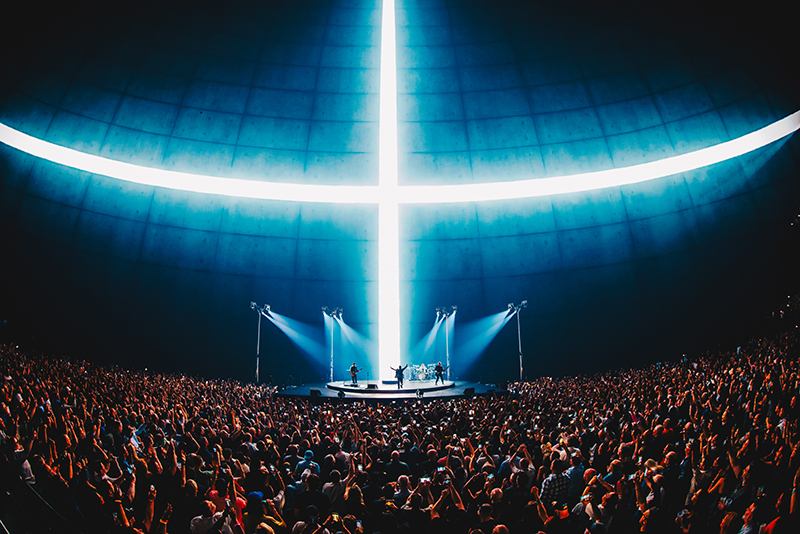
On September 29, 2023, U2 opened its latest production, not on tour, but in Sphere Las Vegas. They kicked off what is now scheduled to be a 36-show run of U2:UV Achtung Baby, Live at Sphere. Working with longtime collaborators Willie Williams, Stefaan “Smasher” Desmedt, and STUFISH Entertainment Architects, among others, the show’s production was realized by longtime U2 veterans as well as new creatives and vendors. After months of working in this exciting new venue, as it was literally being built, they debuted both the space and this incredible production to rave reviews. This month, Williams, Smasher, and STUFISH’s Ric Lipson take us through the elements that supports this groundbreaking production.
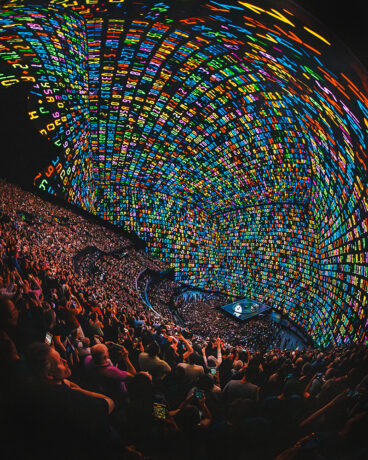
WILLIE WILLIAMS
Creative Director / Lighting Designer
What’s it feel like to be the first to work in this new kind of venue?
We’re all a little bit taken aback at the response. I just plug away doing what I think is interesting. The three shows we made in the five years before the pandemic—iNNOCENCE + eXPERIENCE, and Joshua Tree, and all that, I really thought that was some of the greatest work we’d ever done in terms of what a live show can be. They made a ripple within certain circles, but then to do something like this show where it’s just on fire, it is a whole other thing. Obviously, we’re absolutely delighted. We really had to trust the process on this and believe in what we were doing, and not waver from it. Which was very unusual because usually the hallmark of concert touring is that things change all the time at the last minute. But I said to the U2 guys very early on, ‘This is an ocean liner, not a rubber dinghy. We needed to commit to the show and then build it.’ Of course, knowing what the material was was very helpful. Having Achtung Baby as the central core of it was really useful. I have a storyboard from April, which is pretty much where we ended up with this show. Obviously, with some variations, but the intent has certainly been there, and the big things they committed to haven’t wavered, which is remarkable given that they’re music performers. That commitment was very helpful, I think that’s what made it possible to achieve this.
Talk about the overall design and the evolution to the final design for the show.
For me, I wasn’t really very keen to begin with the notion of starting a show with the building or with the screen. It seems very backwards to me. All the stuff with U2, and with everybody else, all the shows that I’ve made that involve big images, the video surface itself, if you will, it’s always born off the idea and it’s always a unique thing. Whether it’s iNNOCENCE + eXPERIENCE, the barricades thing, it comes from the idea and then the hardware evolves from that. I always tell students, ‘Don’t start with an equipment list. That’s absolutely the way to kill any creativity’. On this it felt like we were starting with an equipment list in the biggest way possible.
Of course, we’re the first people working in Sphere, so there’s a sense of it’s unique, to a certain extent. And, when we started, we were working in a building which didn’t exist yet, so as well as having to imagine a show, we’re having to imagine a building. How everything would work, and what the experience would be like—’will it feel like a shed? Will it feel like a theater?’ But we had enough to go on and, as always, began to imagine what kind of show that they wanted to do. Initially, I wasn’t sure that we would revisit Zoo TV at all. I knew with having done the Joshua Tree show, and saw the way they did that, where they managed to do an anniversary show, an album show, that wasn’t at all nostalgic. They just took the album and looked at it like it was their new record and found a way of presenting it with 21st century eyes. I thought maybe that’s what we do for this; maybe this would be about Achtung Baby, rather than Zoo TV.
Tell us about the Brian Eno inspired turntable that is the stage design.
Brian makes these sculptures, or light paintings as he calls them, which are basically light boxes. Within them, they have just regular LED tape. But he has a technologist, Peter Childers, who he’s worked with for years and years, and they design these algorithms that run the color. They’re very simple. They have certain rules that the red, green, and blue channels have to follow, and you can give them a place to start, and you can set parameters. So, you can tell it how far it’s allowed to wander from the base color, and you can tell it how much time it’s allowed to spend there, just a whole set of rules. So, you end up with this ever-changing series.
I tease Brian about it because he only has the same LEDs as everybody else, but his LEDs make the most beautiful colors, and, of course, they do what they want to do. There’s this whole central section of the show—about 25 minutes—where we lose the big screen and the stage lights up and it just wanders through colors; colors we don’t control. There’s the circle in the middle and the square, and it just does what it wants to do. I was concerned what if it decides to spend 15 minutes on green, which is famously not a good color light for gentlemen of a certain age, me included. So, they wrote some new rules. So, green is only ever allowed to go to 50%… unless either red or blue are above 50%. So, we still get the really nice magentas and color mixes and everything that goes in—but green is not allowed to go it alone. It’s really lovely, and has been the most wonderful thing because, with the amount of shows now, which just absolutely run to track, to have something that’s genuinely completely generative in the middle of the show—be different every night—it’s perfect. Also, that’s the part of the show which is much looser for the band. It’s the ambient, acoustic-y section. Obviously, a lot of the show has to run to click to trigger the video and this, that, and the other thing. So, it’s nice that when we get loose, everything gets loose, including the lighting, which is deciding what it wants to do by itself.
As you noted, it’s an incredibly unique venue. Speak about some of the considerations to the Sphere?
The toughest thing was trying to conceive a show for a building that doesn’t yet exist. VR helped a lot. VR is very useful for figuring out how big things need to be. It’s easier to move around a VR building than in a real one—fewer stairs! So the VR was very helpful, that was a huge part of the process. But some things were really obvious to me that didn’t seem to be obvious to anybody in the building. It was a building site, but when I walked in there for the first time, the first question I asked was, ‘What’s your plan for lighting? Certainly backlight. What have you considered for that?’ They just looked at me completely blankly. Many things were not considered in terms of it being a performance space. So, all those things we had to address as we went forward and really had to solve these things for ourselves. We ended up bringing in the entire custom playback system for the show, because the house playback system is designed to show movies at an incredibly high resolution, which of course it does very well, but it’s not a live show delivery system. There’s no kind of timeline aspect to it. All the things that you would absolutely take for granted in running video for a live show, it has none of those capabilities. So, we had to create and install our own system. There were so many technical things before we could even consider that it would be possible to do a show in there. In a way, we’ve done the R&D for everything else that follows, and there were a lot of surprises along the way.
Tell me about the backlight towers from a scenic point of view?
Yeah, they’re fantastic. Really minimal, but I’m not frightened of that. You have to trust that it will feel coherent to the audience. It was very pragmatic. It was quite a journey to find a way to get any backlight at all that wouldn’t be an eyesore for the big scenic video pieces. I wanted to be able to get them out the way. But actually, I am pleased because they have more character than I thought they would have. Even though I say so myself, the stroke of genius was putting the little red bulkhead lights on them. They feel alive. They have a presence. It’s interesting, because they’re chrome. That was Ric’s suggestion to make them chrome because they will disappear more. The do look a bit sci-fi and can be quite menacing when they lean in. When they’re just part of the picture, they almost disappear and they’re quite beautiful. I’ve really enjoyed playing with them. As all things, we don’t overdo it, but they do have their moments.

STUFISH has a long relationship with U2 and yourself. Talk about working with Ric Lipson and STUFISH on this show.
Two things about Ric. One is obviously he’s just the most enthusiastic person imaginable who has no problem with throwing himself into anything that’s required. But he’s such an all-rounder. He’s literally just as happy sewing a backdrop together as he is fixing a piece of gear and he never stops. There is a joy working with him. It’s interesting, because there’s him, Es, and myself, and even though we’re, on one level, from three different design houses, the three of us really form the core of U2’s creative team. Certainly, for initiating it all. We love it when it’s just the three of us and we get together and we can just blue-sky stuff because we all bring different things. Now, Es is a little less involved, less hands-on, but that’s also completely fine. She brings the connection to the more serious performing arts, opera, and theater. That’s invaluable. Then as I say, Ric is absolutely boots on the ground and has been indispensable on this one. There’s been so many things, God, I’ve thrown at him and he doesn’t blink.
One thing that’s been wonderful has been his insistance of having the Trabant [A tiny East German car that were in William’s design for the 92-93 Zoo TV tour] in this show. I really didn’t want a Trabant, partly because I felt like that was nothing but nostalgia. Also, frankly, Trabants for me stopped being funny in about 1995. Anyway, we have a DJ, and it seemed to Ric, that the obvious thing was to put him in a Trabant. So, Ric has made this Trabant DJ booth, and his commitment to that was absolutely commendable. Also, his commitment to fun fur is commendable! Let’s say it’s his range of skills; there’s not many people that can work in Cinema 4D and happily work with fun fur.
Talk about the challenge of not losing the band in the immense video environment of Sphere.
That clearly will be the biggest challenge for anybody. But always with U2, it’s this dance between spectacle and intimacy. They are really, really good at it. They’re really good at trusting their audience so they can let go and just let it happen. Right back to Zoo TV. I mean, the joke of Zoo TV was, up until that point, they had been this incredibly sincere, no nonsense rock band. We came back with this show, where for the first 15 minutes, it was impossible to look at the band. They’re really okay with that thought because they know if you’re going to go for it, really go for it. Just push it out there. Show people things they’ve never seen before. That’s so thrilling, but they also know they have the power and the ability to play with nothing but the band on a stage.
We don’t do any of this stuff because they need it. It’s not supporting their performance. It’s just that they want to do it. It’s really fun. They want to experiment with it, and when we pull it right back down, that ends up being everybody’s favorite bit; when they perform with nothing. Or in this case, just with the turntable noodling away. That always ends up being everyone’s favorite bit because that’s real. I mean, Bono has a line. He said, ‘he’s not in the business of production; he’s in the business of connection’. All of this serves the purpose where you just thrill people with stuff they’ve never seen before, and then you just make this real emotional connection and that’s how it works. I don’t worry about things with them because I know they trust me enough to make sure the balance is right. But at the same time, you couldn’t do it with many performers because they just wouldn’t have the confidence to let go enough.
Talk about collaborating with Smasher on the video direction of the show.
We have known Smasher since he was on Zoo TV. Smasher and I know each other inside out, and we know the shorthand. He’s a rare animal though, because he not only cuts a great show, but he’s really, really on top of the technical side of things. A lot of the D3 [disguise] effects and camera treatment effects are manual. He’s running them with his left hand. Whereas ever so many directors, they’d be, well, not only would they be programmed in, but they’d be run by somebody else. He’s always done this way thought. We grew up with the technology and he really knows it. Also, the band have complete confidence in him, and it would be hard to do that with a stranger.
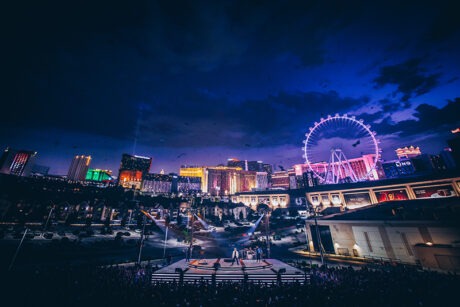
STEFAAN “SMASHER” DESMEDT
Video Live Director, Technical Director:
Talk about the video system. This is all supplied by Fuse Technical Group, correct?
Yes, Fuse supplied the video playback system. They bought 25 disguise servers just to drive the whole thing because the screen is a 16K x 16K canvas amounting to a total of 256,000,000 pixels rendered. It’s massive. I took the risk, and the results are there. It just looks absolutely amazing, just stunning. It’s weird to have looked at it for three months without an audience, but when the audience came in, you see people walking into the venue and baffled by ‘is that concrete or video?’ During the preshow, the video screens all look like concrete and people are absolutely stunned. We don’t hold back; we just blow it up and start with “Zoo TV”, then “The Real Thing”, and “The Fly”—all very intense visual songs. Then we hold back after five, six songs because you have got to give your brain a visual rest. Then, after this midsection, we pick it back up towards the end of the show.
On the camera side, I stepped away from broadcast cameras and went with cinematic cameras. We got eight Sony Venice 2 cameras, that are used to shoot films in Hollywood. These beautiful cinematic cameras that I’m using; I’d rather have less cameras with beautiful shots than just having 20 cameras.
What were some of the solutions you had to come up working in Sphere?
One of the biggest challenges was working in this new format, SMPTE 2110, which is simply video over IP. The video format was not UHD, it’s DCI, which is higher-res—4,096 x 2,160 pixels. We had to develop a whole new method of working because that’s never been used before for video in our world. The challenge was to find manufacturers that were willing to convert the video format. So, there were a couple of things to make this happen. disguise developed new IPVFC cards that can output three times that resolution on their gx 3 servers. So, we had to buy these gx 3s from disguise, with their new prototype IPVFC cards that can handle that resolution over SDI. We had to convert that signal into the SMPTE 2110 standard that the Sphere required.
After many discussions internally with the Fuse team, we determined that monitoring and failover made sense to stay 12G until the last mile delivery of SMPTE 2110 to the venue. They provided 26 primary and 26 redundant feeds via the Matrox Convert IP Series boxes. Matrox’s support team has been excellent dealing with DCI compliance, which was a requirement of the venue. We had to use the Sphere’s Cisco switches. So, all these signals are hitting their switches, but of course you want to check out what’s coming out of our converter boxes as double security. You want to know what are the signals finally coming out. I put an Evertz Multiviewer to monitor it all. All these companies had to make all these firmware changes that were not necessarily perfect from the first of the get-go, but at the end of the day, the results were there and we were fine by August were up and running perfectly.
That whole standard, 2110, was the biggest challenge because it’s such an unknown territory. I was very lucky to bring in Oliver Derynck, our EIC and 2110 wizard. None of this would have been possible without him. He was strongly involved with the Japanese Olympic Games and worked for Olympic Broadcasting Services (OBS). He came on board just to deal with all that. He’s so knowledgeable about that whole system and about that signal flow, how that all works out. So, I was very, very happy to have him here on board with us. Technically, it was very challenging. Also, I cannot thank the people from Fuse that worked on this enough—Bart Ketels on LED Integration & Design, and Patrick Eaton, the Senior Project Manager, and the whole Fuse team.
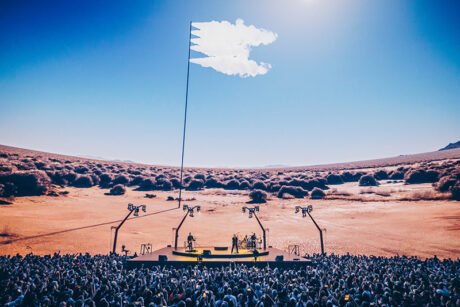
You have worked with Ric Lipson for years on U2. Speak about working with him on this production.
For the design of the stage, we have a good team going there with TAIT, STUFISH, and Ric; we were all very focused on the design. Then we were told that we needed to fit speakers underneath it, and then it had to be a certain height, so Ric took that all on himself. He was absolutely amazing, as always. Ric always sees things that me and you are not going to see, and even Willie’s not going to see. He’s just really tuned in when it comes down to taking something from a drawing into reality. That’s pretty much when Ric comes in there.
Fuse worked on the stage as well, which is a whole custom stage piece that was made to represent the Brian Eno turntable. The stage was built by TAIT and the stage floor is YesTech 3.9mm LED panels with NovaStar processing, and it’s absolutely stunning and super hi-res. We also used some ROE Vanish 8 on there because of the speakers underneath the stage, so we needed acoustic transparency for audio. Of course, there were some challenges with the LED turntable as well. ‘How are you going to build those corner pieces? The circle?’ There were a lot of custom pieces that had to be built. You go to a manufacturer, and you ask, ‘I need these custom-built pieces’ I’d say 120 custom-built pieces. Not only did we need a lot of custom pieces, but we needed it all in like a month, but everyone was very responsive. It just turned out to be absolutely amazing.
How about your working relationship with Willie, which goes back over 30 years?
I was in London and Willie asked me to have a cup of tea last August. I was retired and then that cup of tea, along with a request to go out and handle Bono’s book tour. That led to us all working on this whole Sphere production, but we have had fun. Fun and tears, because it was not an easy project to put together. At the end of the day, it’s not your own building, it’s not your own screen, it’s not your own people that you deal with on something like this. There was a lot of stress in that respect, but the triumph has been enormous. You can see people care about it; they fly all over the world just to see this.
There was also a Technical Director for Content you worked with, correct?
I have to give credit to [Technical Director, Content] Brandon Kraemer who worked for Treatment. He took care of all that, because I dealt more with the servers and the technical signal flow of the whole system. I TD’d the system, and then Brandon TD’d the whole workflow for the visual creators. I cannot talk more highly about him because he took that all on board and he also made “The Fly” piece. So, for him, it was very challenging as well, just how to coordinate all that because it’s not just a flat surface. For example, there’s a square in the content for the song “The Fly”; he just changed the whole perspective view. The way he technically explained it to people, he made a template for them to fill in, to help them make content for this screen. He took that fully on board. I’m not going to take any credit for it. I understood what he was doing, but he just made a point of dealing with all the artists, that usually shoot 16:9 film format or 4:3 ratio, and said to them, ‘Here’s this really complex pixel map, and this is how you’re going to make your content.’ So that was very, very challenging for John Gerrard, for ILM, and for all these artists that were involved with it, but they all did it well. Again, Brandon Kraemer, I’ll give him 100% credit for getting that all done.
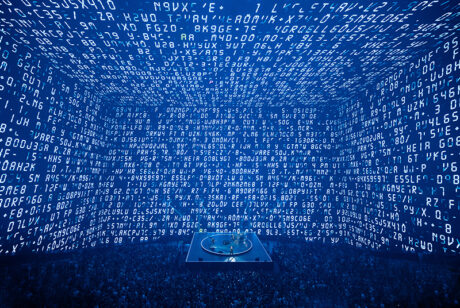
Were there any moments or songs that really captured what you were trying to do with video?
Well, I think the best example is “The Fly”. The whole changing the architecture that you don’t even realize you’re in a sphere, but visually you’re in this cube box. I think that’s very fascinating. The first time we saw this screen in Burbank at the quarter-scale setup, I mean, everyone almost, to be honest, threw up. They had this rollercoaster content in there, it was just like being on a ride at Universal Studios or something. So, that was the thing that we’re trying to avoid, we don’t want to make people sick. There are some pieces in the show that are borderline of being sick; you don’t want to walk around with four beers in your hand and watch that film at the same time. But the main challenge was changing the architecture that were not only in a sphere, but we can change visually the architecture through imagery, and I think that was really, really challenging; and really fun.
Is there anything you’d like to say about being the first working in Sphere?
I don’t think about being the first or whatever, but yes, I’m really happy. I’m pleased that I’m the first one in there. Again, the technical was more challenging than some of the creative, but they all work hand in hand. You follow the creative, but it was not easy. It was not easy being in a brand-new building. I cannot thank the owners of Fuse enough to make this run possible. We’re still a fairly new company, just a fantastic company to work for.
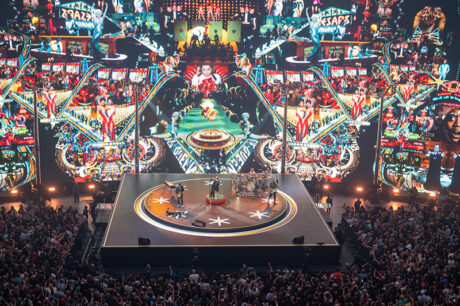
RIC LIPSON
Set Designer, STUFUSH Entertainment Architects
Talk about your overall design approach for this show.
The Sphere itself obviously is vast and unlike most of the shows that we’ve done. Usually we’ve been the designers of not only the stage that the band stand on, but the backdrop of the environment. We create the whole of the set—we control the video screens, speakers, stage, etc. But the great challenge here was that there was no means to hang the screen or PA because it’s all there in the building itself, how do you make the stage feel connected? How do you make the band not feel daunted by the screen? etc. So, the idea of a stage that was a video stage came quite early. Because of that, when it was in development, this show was more about displaying art than it was going to be about video. It was decided that the Sphere would lend itself quite well to making pieces specific for it. That led to the conversation of where would we do the staging? We couldn’t cut into the Sphere screen and the floor of is very strange because it is like an eye shape, like a squashed lemon. We really wanted a general admission (GA) audience, we could choose not to, but that was something we wanted to have and that meant it could only have a certain room where we could fill the whole floor.
We were thinking about those things, and Bono has this wonderful turntable made by musician/producer Brian Eno. He made a series of Lexan record players that change color, generated by an algorithm, of the LEDs inside. There’s a square section and a round section, both of which can change color. The color is generative and it’s really beautiful. We knew at this point that there would be two sections—an Achtung Baby celebration and a middle section was going to use songs from the Songs of Surrender (SOS) album. The world of Zoo TV would be massive, bold, and flashy. That would go on the big screen. Then they wanted some way of making the show have a B-Stage moment for the SOS album and feel different. The record player, we felt, was very interesting and so we have a brand-new record player stage. Also, since Larry Mullen Jr. isn’t playing the drums for this show; with Bram van den Berg filling in, who is amazing, the drum kit has shifted its position. Normally, the drum kit would go in the center, but Bram is now shifted off center and is close to where Adam plays. This was transformative to the stage space because the center axis of the stage has opened up visually, and physically. Over the years, especially since the Joshua Tree experience, we have reduced the amount of stage equipment quite significantly to make the stage feel cleaner and more modern. This stage is no different, there’s not much on it outside of monitor wedges, the keyboard, and drum kit.
Talk about the technical aspects of the turntable stage.
The record player became a custom, circular video screen. We worked with Fuse Technical Group on that, and they did an amazing job. TAIT built most of the structural stage, and then Fuse added the video elements on top. Traditionally we would have a five-foot-high stage with a seven-foot-high technical bunker. The fun with that is we didn’t want a bunker and we didn’t necessarily want a seven-foot-high fixed stage. So, in the end, we did something we’ve never done before, we made the back end seven-foot-six and made the front end six-foot high. That gave us space under the stage for the crew and we wanted the people in the GA section to have a semblance of the video floor—color, video, textures, whatever we were doing in the moment. But also, it creates a very interesting visual dynamic energy between the rear screen and the floor. When it’s not so bright, the stage becomes the recessive object allowing the audience to see the large images. And when we turn off the large images and put the floor on, it becomes bigger in the room. When you emit light from something, it feels bigger.
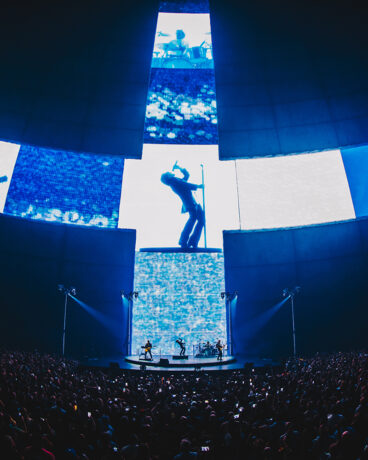
Tell me about the scenic aspect to the backlight solution that was created for the lighting needs.
We rigged some lights to blast through the screen for a few given moments of the show, but that was not going to be enough to backlight the band. The band needs, like any artist, a strong backlight that lifts them out from the video so that they look good on camera. The problem was that you could not do that by blasting through the video screen constantly. Even if you could do it, you’d end up with a circle of light on the screen, which wouldn’t look good. So very early on, I was trying to find the right way of creating backlights as a part of the stage design. We went through a few iterations of ideas, of structures, and whatever. We were looking at having ribbon lifts or things that would pop them up when we needed them. But, in the end, they really all competed. There was this moment when it was like, ‘Well, why would I even not want those lights out all the time?’ Then Willie realized, of course, that he needed some backlight on track. That is when these streetlights or towers emerged.
At certain times in the show, the streetlight towers might be fine, but really, in some places, you wanted them not to be there. We were having this conversation about ‘how do you make the streetlight go away or how do you make it go lower?’ Because we were thinking about that, and we were thinking about oil rigs, the heating sea, and all these things, we decided that it would be quite interesting if the lamppost could bow a bit like oil derrick. They could bow, get out of the way, but it also might be interesting in songs like “The End of the World,” or other songs, where the lights could get lower and lean in and create a more intimate feel.
Again, we have no set as such; we have a beautiful stage and a vast screen. The only element that we could make that would actually become part of the design, were these towers. But we wanted them to disappear. By wrapping them in chrome, a little trick we learned on Beyoncé earlier this year, it reflects all the light around it, so it looks smaller and disappears more. We made these four light posts that bow down and they’re really effective. They look like cranes, or something out of Pink Floyd. Each has three spotlights on each and they are remotely controlled followspots. And there are little red beacons on each, which is a Willie Williams’ special. The light towers were fabricated by Y-Lines out of Belgium. We know the owner, Yves Vervloe from his work with Jake Berry and EDC.
Then of course, there’s Treatment who created the video content. We started the show in the ‘Concrete Cave.’ This idea of the very first places where people performed and created light and performance was in the cave back years ago. We liked this idea that when the audience came into Sphere, it would feel like a cave, a modern cave. It’s a concrete bunker that then splits open right at the beginning of the show, inspired by Tadao Ando’s Church of the Light. That then splits open and reveals the Zoo Station video intensive flicking world from Zoo TV because we’re celebrating that. There’s a huge amount of layers of every U2 show driven by Willie and the band, mainly with Es consulting and myself and STUFISH putting the physical world together. That’s how it all came around. Obviously, the other key person is [Production Manager] Jake Berry, who pulled the whole thing together. It’s a long-time U2 family. STUFISH has had a very long association with U2, and it’s been rewarding as a designer to go through all these iterations with the team.
It’s got all the bits—it’s got some nostalgia, it’s got some futurism, it’s got art. The stage, it’s a sculptural art piece. It’s not a rock and roll stage. It’s got where it can feel very theatrical. When you’re looking at it, it feels very energetic. These light poles look like something out of the future. They’re chrome and sexy, and they bow, and they have this character of their own. And then across the screen, they, allow the most mesmerizing, immersive moments of the show ever, that extend the space, the visual space of the band’s performance, whilst other times really focusing the attention, so it’s really interesting.
What surprised you about working in the Sphere?
I think I was surprised by how small it can feel at times. If you get it right, the intimacy of it can feel quite different, more intimate than we thought and that was a nice surprise.
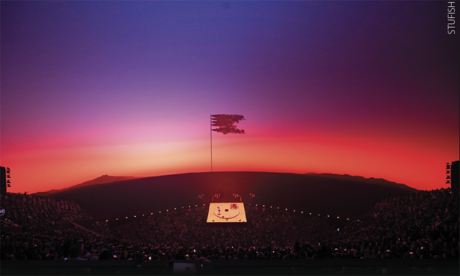
PRODUCTION TEAM
- Creative Director, Lighting Designer: Willie Williams
- Set Designer: Ric Lipson, STUFISH Entertainment Architects
- Production Manager: Jake Berry
- Associate Director: Mike Smith
- Video Live Director, Technical Director: Stefaan “Smasher” Desmedt
- Technical Director, Content: Brandon Kraemer
- Live Content Producer: Treatment Studio
- Lighting Directors: Alex Murphy, Ethan Weber
- Lighting Consultant: Allen Branton, Felix Peralta
Video Crew
- Video Crew Chief: John Myrato
- LED Lead: Tyler Raphalian
- LED Techs: Kurtis Lopez, Jason Regan
- EIC: Oliver Derynck
- disguise Tech: Austin Hammond
- disguise Programmers: Matisse Desmedt, Rodd McLaughlin
- disguise Operators: Matisse Desmedt, Sean Green
Lighting Crew
- Lighting Crew Chief: Christian Reyes
- Lighting System Tech: Matt Beecher
- Follow Me Spot Supervisor: Tom Hawkes
- Lighting Techs: Jacob Hunt, Jacob Hinrichs, Ryan Torok, Ezekiel Figueroa
Fuse Technical Group
- Account Manager: Matt McCormick
- Project Manager: Alan Peterson
- Follow Me Spot Support: Tom Huston
VENDORS
- Lighting & Video: Fuse Technical Group
- Content: Treatment Studios
- Stage: TAIT
- Automated Lighting Towers: Y-Lines
- Soft Goods: Rose Brand
- Scenic and Prop Fabrication: SRS Fabrication, Inc., Electric Sky
GEAR
VIDEO
LED Turntable
- 812 YesTech MG7S 3.9mm Floor Panel
- 56 YesTech MG7S 3.9mm Custom Circle Panel
- 2 YesTech MG7S Custom Corner Panel
- 168 YesTech MG11 Panel
- 42 ROE Vanish 8T 1m x 1m Panel
- 63 DesignLED 400 x 225mm Custom Flexible Tiles
- TAIT Structure & Staging Support
LED Processing
- 9 NovaStar MX40 Processor
- 18 NovaStar CVT-10 Pro S Fiber Receiver
- 2 Brompton SX40 Processor
- 2 Brompton XD10 Fiber Receiver
Video Servers/System
- 23 disguise GX3 Servers w/ IPVFC Card
- 1 Utah 288×288 12G Router
- 30 Matrox Convert IP DRS 12G to 2110 Converter
- 8 Matrox Convert IP DSS 2110 to HDMI Converter
- 11 Cobalt 9915DA – 4×16 12G DAs with SFP’s
- 2 Cobalt 9971MV18-4K Multiviewer
- 1 Evertz 5700MSC Master Clock
- 1 Evertz ev6-FR+PS 2110 Multiviewer
- 30 Matrox Extio N3408 IP KVM TX
- 6 Matrox Extio N3408 IP KVM RX
Lighting
- 24 Robe Forte FS
- 24 Robe Forte
- 119 GLP JDC1 Hybrid Strobe
- 30 GLP XDC1
- 60 CHAUVET Strike One
- 36 Astera Hydra Panel
- 6 Astera AX2 Pixel Bar, 50cm
- 25 Wildfire VS-120 UV
- 15 TMB Solaris Quasar 15K Strobe
- 8 MDG theONE Atmospheric Generator
- 4 Robe RoboSpot Controllers
- 1 Follow-Me Remote Followspot System
- 1 Luminex Data System
- 3 MA Lighting grandMA2 full-size
- 2 MA Lighting grandMA2 light
- 6 MA Lighting NPU
- 2 MA Lighting onPC
- 2 CRMX Transmitter
Next month PLSN will look at the lighting, live image capture, and content creation for U2’s Sphere residency.


